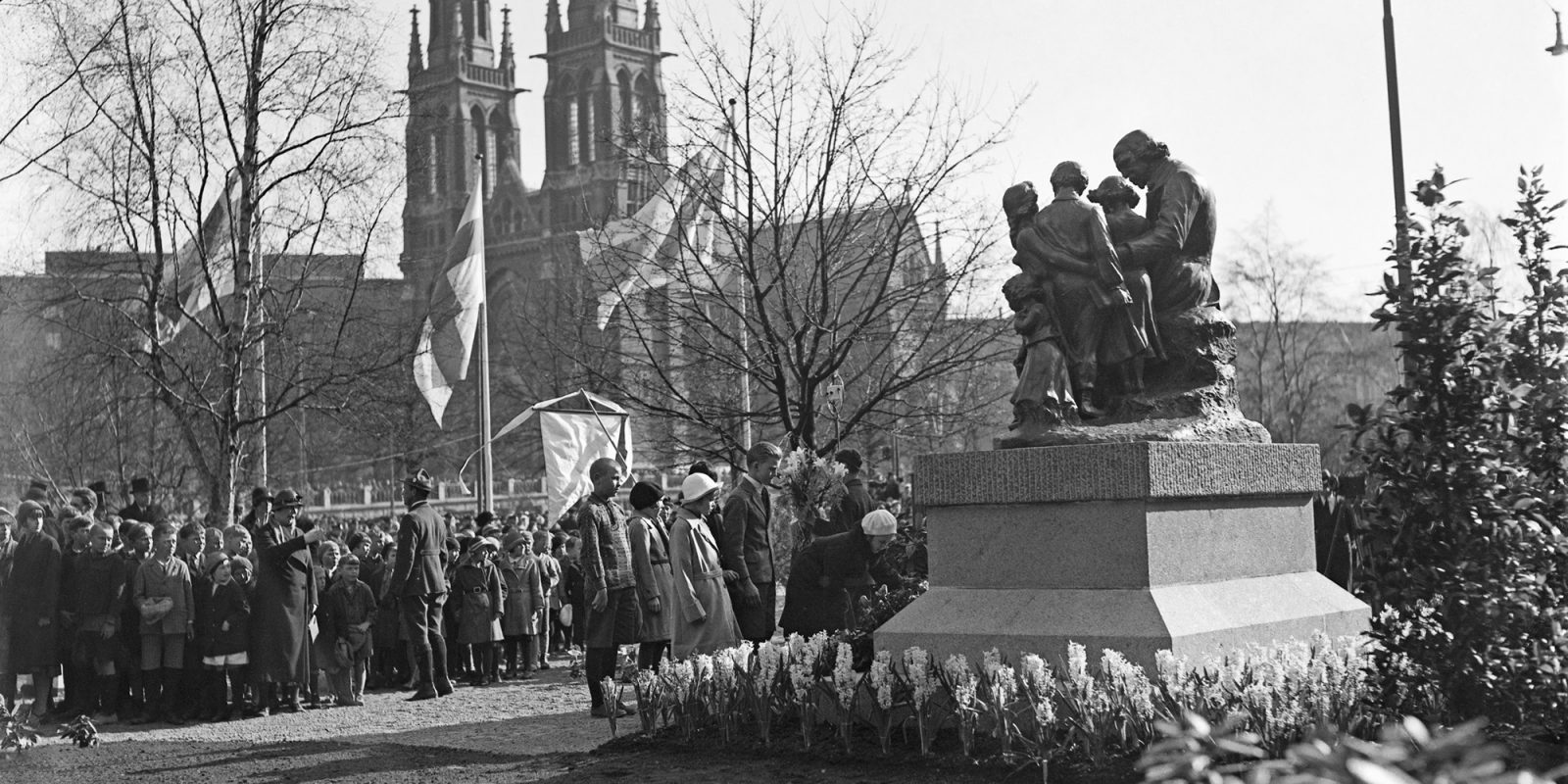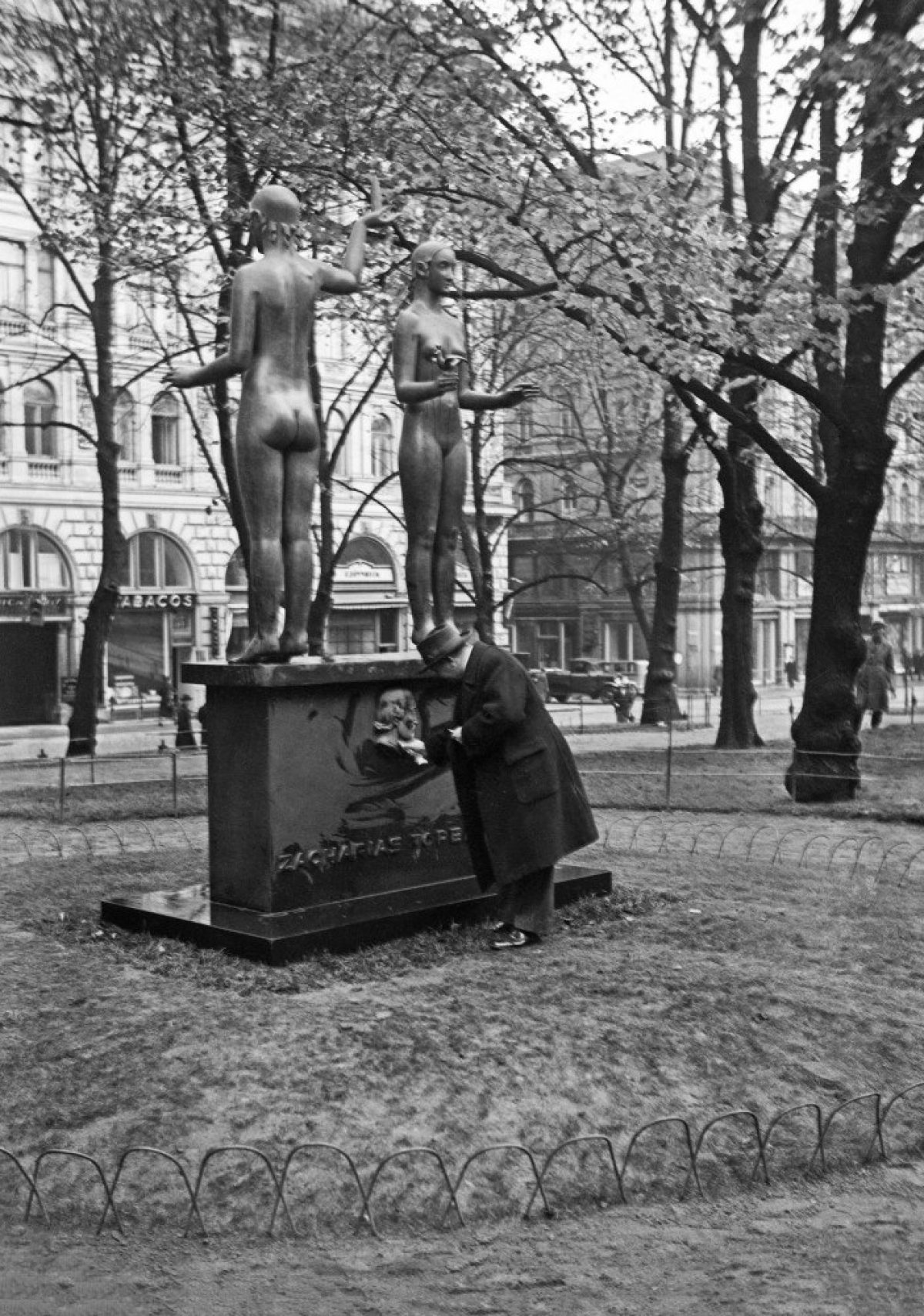
An end to an argument over a statue
Press photographer Hugo Sundström recorded news images of the past for future generations.
Public artwork always sparks a debate and tends to cause controversy. That was what happened when a memorial to author Sakari Topelius was proposed in Helsinki. Sculptor Ville Vallgren had already submitted his proposal for the statue in 1909, but the children surrounding the writer in the draft version were thought to be too French in style, and the proposal was rejected.
Two decades later, Svenska Litteratursällskapet SLS held a competition for a memorial, and the winner was Gunnar Finne with his entry Fact and Fable. The piece caused quite a commotion among the press, and the public found it difficult to accept that the great storyteller should have such an allegorical statue. The nakedness of the figures was also considered to be inappropriate. They would have preferred the national poet to have a likeness, but Fact and Fable was commissioned, regardless.
In 1931, a group of private individuals proposed that Ville Vallgren’s design be chosen to create Topelius’s statue. The parallel piece, Topelius and Children, was completed first, and an impressive ceremony was held in the Ratakatu park on 13 May 1932 to reveal the memorial. The ceremony was attended by President P. E. Svinhufvud and other top-tier politicians, as well as a large number of ordinary citizens. Fact and Fable was revealed five months later in the Esplanadi park with far fewer people present. Newspaper Hufvudstadsbladet’s photographer Hugo Sundström’s press photos illustrate the difference between the two events.
Hugo Sundström (b. 1907) served as the head photographer for Hufvudstadsbladet, Svenska Pressen and Nya Pressen from 1928 all the way to his death in 1973. Until the 1950s, he was in fact the only photographer working for Hufvudstadsbladet. During the war years, 1939–1944, Sundström took photographs for the so-called communications company of the Defence Forces. He was also one of the founding members of the Finnish press photographers’ club, established in 1947.
Sundström, who was from Helsinki, was working as a photographing chemigrapher in the printing plate company Kuva’s side branch when Hufvudstadsbladet bought out Kuva and its staff at the end of the 1920s. He was hired as a press photographer almost immediately. Sundström was known for his professionality and punctuality, and it was said that he was never ill. Editors could count on him to always be able to take at least one picture that could be published.
Photography equipment was heavy at the time when Sundström was a young press photographer at the start of his career. This made the work of press photographers difficult without a car. However, Akseli Neittamo, who was Sundström’s senior by 15 years, served as a reliable guide and often used his own car to drive Sundström to news locations. After a long day at work, they would go to restaurant König to relax and discuss the day’s events. Later, press photographer Osvald Hedenström would also join them.
It is likely that Sundström did not know what he was getting into when he was hired as a press photographer. His new job took him outdoors, the pace of work was hectic and the days were long. In addition to photography, the work involved developing negatives and copying photographs. From 1931 onwards, the Hufvudstadsbladet photograph service supplied pictures to foreign clients, regional newspapers in Finland and private individuals. Press photos were posted on the office building’s ground-floor windows and display cases to attract customers.
Hugo Sundström’s career spanned six decades, during which photography technology improved, cameras became light and glass plates were replaced by sheet and roll film. Sundström managed to capture almost all of the major news events during his career.
Hufvudstadsbladet’s old picture archives were donated to the Press Photo Archive JOKA in 2021. Material connected to the project is available at museovirasto.finna.fi/joka and www.kulttuuristaperinnoksi.fi/2022/hauraat-kuvat-nuoresta-suomesta (in Finnish).
Text: Joanna Maltzeff
Kamera 7/2022

Sakari Topelius’s memorial being revealed in the Ratakatu park on 13 May 1932. The piece was created based on Ville Vallgren’s draft design. The purpose of the statue was to celebrate both Topelius and the children of Finland. Photo: Hugo Sundström

Gunnar Finne cleaning the medallion portrait of Topelius on the monument Fact and Fable before the ceremony at the Esplanadi park in Helsinki on 12 October 1932. Fact and Fable is an allegory of Topelius’s writings. The piece caused plenty of polemic in the press, because its nakedness was deemed to defame Topelius’s memory. Topelius’s name and portrait were added to the pedestal. Photo: Hugo Sundström